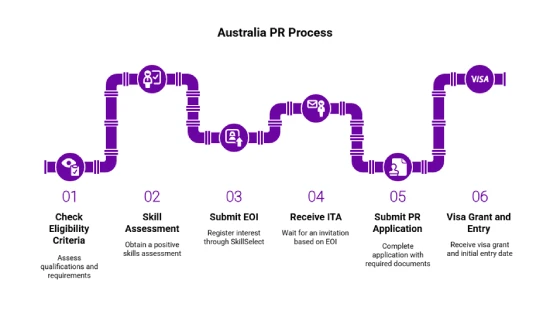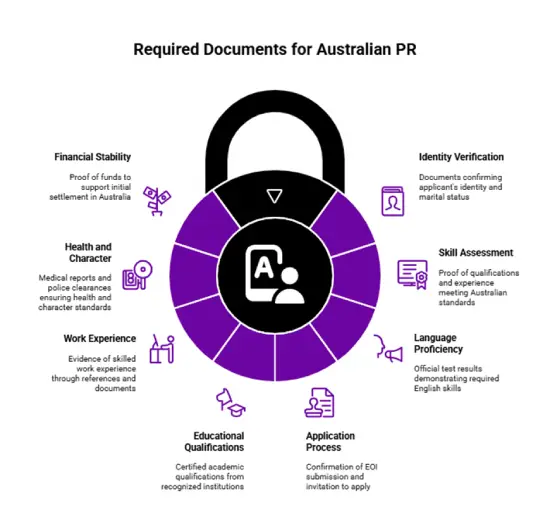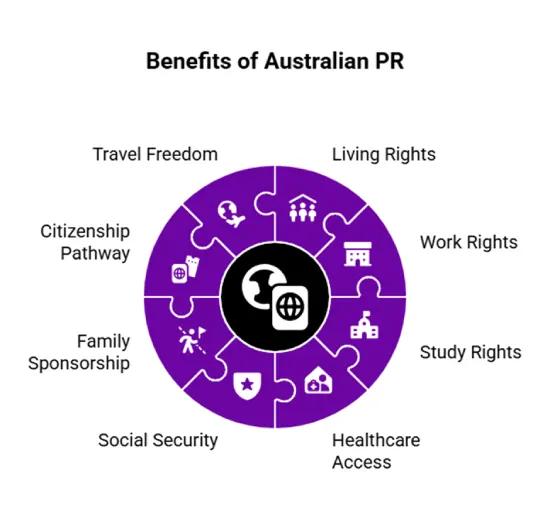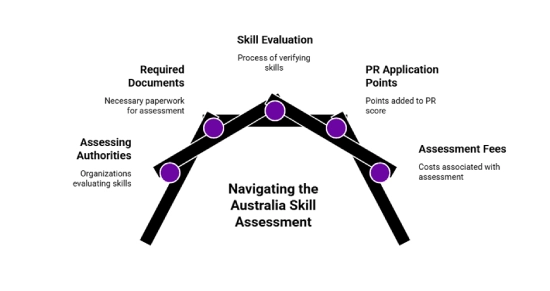Applying for an Australian Permanent Residency (PR) provides the right to live, work, and study in Australia indefinitely. PR holders access healthcare through Medicare, social security benefits, and education at Australian institutions. After four years of PR status, you can apply for Australian citizenship and obtain an Australian passport. The Australian government prioritizes skilled migrants, making PR an attractive option for professionals seeking better opportunities and quality of life.
*Want guidance to apply for Australia PR? Let Y-Axis assist you with the process.
The process to obtain Australian Permanent Residency involves several key stages that applicants must complete to be eligible for a PR visa. These stages ensure that candidates meet the necessary criteria and submit the correct documentation for a successful application. The main stages of the Australia PR process are:

Following these stages carefully and providing complete documentation will help streamline your Australia PR process and increase your chances of obtaining permanent residency.
*Looking to apply for Australia PR? Sign-up with Y-Axis for comprehensive support with the process.
Australia provides several visa pathways for Permanent Residency (PR), catering to skilled workers, family members, and investors. These visas allow eligible applicants to live, study, and work in Australia indefinitely and apply for citizenship after meeting residency requirements. The main visa categories include skilled visas, family stream visas, and business or investment visas. Choosing the right visa depends on your eligibility, occupation, and personal situation. Common visa options for Australian PR include:
To apply for Australian Permanent Residency, candidates must meet eligibility criteria including age, English proficiency, work experience, education, and nominated occupation, verified by a skills assessment. A minimum score of 65 points on the Australia PR points calculator is required to be eligible. Higher scores increase the chances of receiving an Invitation to Apply (ITA) sooner.
| Eligibility Factor | Maximum Points |
|---|---|
| Age | 30 |
| English Language Proficiency | 20 |
| Skilled Work Experience | 20 |
| Educational Qualifications | 20 |
| Nominated Skilled Occupation | Required |
| Australian Study Requirement | 5 |
| Partner Skills | 10 |
Key Factors Affecting Australia PR Points
| English Test Score (IELTS Bands) | Corresponding Australia PR Points |
|---|---|
| 8.0 and above | 20 |
| 7.0 to 7.5 | 10 |
| 6.0 to 6.5 | 0 |
| Skilled Occupation Category | Points Awarded |
|---|---|
| Medium and Long-term Strategic Skills List (MLTSSL) | 20 |
| Short-term Skilled Occupation List (STSOL) | 10 |
| Regional Occupation List (ROL) | 5 |
These points contribute towards the total Australia PR points score required to receive an Invitation to Apply (ITA). The nominated occupation must be on the latest skilled occupation list.
| Skill Assessment Result | Australia PR Points Awarded |
|---|---|
| Positive skills assessment | Required for eligibility |
| Trade qualification completed | 10 |
| Professional qualification recognized | 15 |
| Advanced or specialist qualification | 20 |
| Work Experience (Years) | Australia PR Points Awarded |
|---|---|
| Less than 3 years | 0 |
| 3 to 4 years | 5 |
| 5 to 7 years | 10 |
| 8 to 10 years | 15 |
| More than 10 years | 20 |
| Education Level | Australia PR Points Awarded |
|---|---|
| Doctorate degree from an Australian university | 20 |
| Doctorate degree from a recognized overseas university | 20 |
| Bachelor degree or higher qualification from an Australian university or recognized overseas institution | 15 |
| Diploma or trade qualification from an Australian educational institution | 10 |
| Australian study requirement (additional points) | 5 |
| Partner Skills Criteria | Australia PR Points Awarded |
|---|---|
| Partner has competent English proficiency | 5 |
| Partner has proficient English proficiency | 10 |
| Partner has a suitable skills assessment | Additional 5 points (if applicable) |
These factors are assessed on a case by case basis, and applicants must accumulate a minimum of 65 points to be eligible to receive an Invitation to Apply (ITA) for Australian PR.
*Want to check your eligibility for Australia immigration? Avail Y-Axis Australia Immigration Points Calculator for FREE and instant result.
To apply for Australian Permanent Residency, you must meet several eligibility criteria and submit a comprehensive set of documents to support your application. These documents verify your identity, qualifications, skills, health, and character, ensuring you meet the Australian government’s visa requirements.
The documents required to apply for Australia PR are given below.

Ensuring that all documents are complete, authentic, and correctly certified will help avoid delays or refusals in your Australia PR application. It is advisable to keep both original and scanned copies of all documents for submission and future reference.
Obtaining Australian Permanent Residency involves several key steps to ensure eligibility and accurate document submission. Follow these steps to improve your chances of a successful application:
Step 1: Check your eligibility based on age, skills, work experience, and language proficiency.
Step 2: Complete a skills assessment with the relevant authority.
Step 3: Submit an Expression of Interest (EOI) via SkillSelect.
Step 4: Receive an Invitation to Apply (ITA) based on your points and occupation.
Step 5: Lodge your visa application with all required documents and await approval.
Obtaining Australian Permanent Residency (PR) offers numerous advantages, including the right to live, work, and study in Australia indefinitely. PR holders gain access to healthcare, social security benefits, and can sponsor eligible family members for migration. Additionally, after fulfilling residency requirements, PR holders can apply for Australian citizenship, unlocking further rights and privileges.
Key benefits include:

An Australian PR (Permanent Residency) visa allows eligible foreign nationals to live, work, and study in Australia permanently. While not citizens, PR holders enjoy many rights similar to citizens, including access to Medicare, social security, and the ability to sponsor eligible relatives. The visa is valid for five years with travel rights to leave and re-enter Australia multiple times. After meeting residency requirements, PR holders can apply for Australian citizenship by passing a citizenship test.
Holding PR provides a pathway to citizenship, granting full rights like an Australian passport and voting. PR holders must maintain visa conditions, including entering Australia before the initial entry date or applying for a Resident Return Visa if the travel facility expires. Understanding these requirements helps applicants navigate the immigration process and plan their future in Australia.|
The Australia 189 visa, or Skilled Independent visa, is a points-based permanent residency visa for skilled workers without employer, state, or family sponsorship. It allows permanent residence and work anywhere in Australia. Applicants must submit an Expression of Interest (EOI) and receive an Invitation to Apply (ITA) based on points. This competitive visa targets skilled migrants who can support Australia's economy and labor needs.
Eligibility criteria for Australia 189 visa:
The Australia 190 visa, or Skilled Nominated visa, is a points-based permanent residence visa for skilled workers nominated by an Australian state or territory. It allows you to live, work, and study in that region and offers a pathway to citizenship after meeting residency requirements. Applicants must meet eligibility criteria and receive an invitation based on their points and nomination.
Eligibility criteria for Australia 190 visa:
The Australia 491 visa, or Skilled Work Regional (Provisional) visa, is a points-based provisional visa for skilled workers nominated by a state or territory government or sponsored by an eligible family member living in a designated regional area. It allows you to live, work, and study in regional Australia for up to 5 years, with a pathway to permanent residency via the Subclass 191 visa. Applicants must submit an Expression of Interest (EOI) and receive an Invitation to Apply (ITA) based on their points score. This visa aims to boost regional economies and address local skill shortages.
Eligibility criteria for Australia 491 visa:
The detailed procedure to apply for Australia PR is given below:
Step 1: Check eligibility by confirming your occupation and assessing authority, take an approved English test (aim for Proficient/Superior), and calculate your points (target 65+).
Step 2: Create or log in to ImmiAccount, lodge your Expression of Interest (EOI) in SkillSelect, and keep your profile accurate and up to date.
Step 3: Monitor invitation rounds and, if applicable, apply for state/territory nomination to boost competitiveness.
Step 4: When invited, submit your online visa application by the deadline with all required documents (identity, skills assessment, English, work, health, character).
Step 5: Track your application status, promptly respond to any requests, and await the processing outcome.
Australia has over 800,000 job vacancies across sectors like healthcare, engineering, IT, and construction. With an average skilled worker salary of around AUD 85,000, it offers excellent career prospects and a high quality of life, making it a top choice for those seeking Australian Permanent Residency.
The list of most-in-demand jobs in Australia along with their annual salaries is given in the table below.
| Occupation | Annual Salary (in AUD) |
|---|---|
| IT | $110,989 |
| Marketing & Sales | $103,078 |
| Engineering | $114,311 |
| Hospitality | $81,460 |
| Healthcare | $107,083 |
| Accounting & Finance | $90,157 |
| Human Resources | $81,078 |
| STEM | $106,909 |
| Nursing | $87,750 |
| Teaching | $88,944 |
The total Australian PR cost is around AUD 4,640 on average, depending on the visa subclass and individual circumstances. It typically includes visa application fees, skill assessment, medical exams, and other expenses. Additional fees may apply for dependents, English tests, and document certification.
| Expense Category | Approximate Cost (AUD) |
|---|---|
| Visa Application Fees | 4,000 - 4,640 |
| Skill Assessment | 300 - 3,000 |
| Medical Examination | 200 - 500 |
| English Language Tests | 300 - 400 |
| Police Clearance | 50 - 100 |
The Australia Skill Assessment is a vital step in the Australia PR process, where your qualifications and work experience are evaluated by the designated assessing authority for your occupation. This ensures your credentials meet Australian standards and that you have the skills needed for the labor market.
Common authorities include Engineers Australia for engineers, the Australian Computer Society for IT professionals, and Trades Recognition Australia for trades. The process involves submitting educational certificates, employment references, and possibly passing technical tests.
A positive skill assessment is required to proceed with your PR application and adds points to your Australia PR score. Completing trade qualifications or advanced certifications can earn extra points.

Assessment fees vary by authority and occupation, generally ranging from AUD 600 to AUD 3,000. For example, Engineers Australia charges around AUD 1,000 to AUD 1,500, and the Australian Computer Society about AUD 1,200.
The processing time for an Australia PR visa varies by subclass and individual cases. Skilled visas like subclass 189 and 190 generally take 6 to 9 months. Delays may happen if additional documents are needed or further assessment is required. Submitting complete and accurate documentation helps avoid delays. Approximate processing times for popular subclasses are:
| Visa Subclass | Approximate Processing Time |
| Subclass 189 | 8 to 9 months |
| Subclass 190 | 6.5 to 8 months |
| Subclass 491 | 12 to 14 months |
Several factors influence the processing time of an Australia PR visa, including application volume during peak seasons, case complexity, and document completeness. Delays often arise from requests for additional information. Seasonal changes and policy updates also affect timelines. Submitting a thorough and accurate application helps reduce delays and speeds up visa approval.
Some of the primary factors that influence the processing time for Australia PR visa are given below:
Investing in Australia through the PR pathway secures permanent residency and offers strong financial benefits. Australia’s stable economy provides opportunities in real estate, stocks, and business ventures, often yielding much higher returns than traditional investments like fixed deposits or gold.
As a permanent resident, you gain access to Australia’s job market, healthcare, education, and social security, ensuring a high quality of life for you and your family.
This blend of economic opportunity and lifestyle benefits makes investing in Australia PR a smart choice for a prosperous future.
Y-Axis is a leading immigration consultancy with over 15 years of experience in Australian permanent residency and skilled migration. They provide personalized guidance to help you meet eligibility criteria and submit a strong Australia PR application.
Key services offered by Y-Axis include:
With expert knowledge and dedicated support, Y-Axis simplifies the Australian immigration process and offers complete guidance for skilled workers, family members, and investors aiming to become Australian permanent residents.
Explore what Global Citizens have to say about Y-Axis in shaping their future
Australia Skill Stream Visa
Aman Maan, Australia Skill Stream Visa.
Read More...
Australia Skill Stream Visa
Divya Vaidyanathan gave a feedback after
Read More...
Australia Skill Stream Visa
Faisal Shah gave a feedback after receiv
Read More...
Several trusted migration consultancies in Dubai can assist with the Australian permanent residency, and Y-Axis is among the leading choices. As a registered and experienced migration consultancy, Y-Axis offers end-to-end support, including eligibility assessment, skills assessment guidance, document preparation, and visa application submission.
We also provide expert advice tailored to your profile, ensuring your application meets Australian immigration requirements. Beyond the application process, Y-Axis offers pre-departure orientation and settlement assistance, making your move to Australia smoother and stress-free. With a proven track record of helping thousands achieve their PR goals, Y-Axis can be your trusted partner throughout the journey.
The most popular pathways to get Australia PR from Dubai include:
Skilled workers can apply through the General Skilled Migration (GSM) program:
Step 1: Choose a visa: subclass 189 (Independent), 190 (State-nominated), or 491 (Regional).
Step 2: Get a skills assessment from an approved authority.
Step 3: Submit an Expression of Interest (EOI) via SkillSelect.
Step 4: Receive an Invitation to Apply (ITA).
Step 5: Lodge your PR application with supporting documents.
Note: You must score at least 65 points based on age, education, work experience, and English skills.
The main PR visa categories include:
Note: Each visa has unique requirements, benefits, and processing times, so understanding them can help you select the most suitable path.
To be eligible for Australian permanent residency from Dubai, you need to meet several key requirements. Below are the main eligibility criteria in detail:
The Australian Department of Home Affairs website provides detailed visa checklists for each subclass, including documents, forms, and requirements. You can also request a personalized checklist from a licensed migration agent in Dubai, who can tailor it to your profile and visa type.
A typical checklist includes:
Note: Following a proper checklist can prevent delays caused by missing documents.
The typical costs for Australia PR include:
| Factors | Approximate Cost |
|---|---|
| Skills Assessment | AUD 300 to 1,000 |
| English Test (IELTS/PTE) | Around AED 1,000 |
| Visa Application Fee | Starts from AUD 4,640 (Subclass 189) |
| Medical and Police Checks | AED 500 to 1,000 |
| Consultancy Fees | Varies by agency |
Students who complete their studies in Australia have several pathways to apply for Australian Permanent Residency (PR). The Skilled Graduate visa (subclass 485) allows temporary work experience, boosting eligibility for permanent skilled visas like the Skilled Independent (189) or Skilled Nominated (190).
Australian qualifications also earn extra points in the PR points system, increasing chances of receiving an Invitation to Apply (ITA). State or territory nomination under subclass 190 may further enhance PR prospects. Overall, Australian education offers multiple routes to permanent residency.
Calculating your Australia PR points considers age, English proficiency, work experience, education, Australian study, and partner skills. A minimum of 65 points is needed to apply, with higher scores improving your chances of receiving an Invitation to Apply (ITA) sooner. Using a points calculator helps estimate your score and identify areas to improve for a successful skilled migration application.
Detailed information about the points distribution system is given in the table below.
| Factor | Points Awarded |
| Age | Up to 30 points |
| English Proficiency | Up to 20 points |
| Skilled Work Experience | Up to 20 points |
| Educational Qualifications | Up to 20 points |
| Australian Study | 5 points |
| Partner Skills | Up to 10 points |
Yes, scoring 75 points makes you eligible and increases your chances of receiving an Invitation to Apply (ITA) for Australian Permanent Residency (PR). The minimum required is 65 points, so 75 points gives you a competitive advantage in the skilled migration program, especially for visas like the Skilled Independent (subclass 189) or Skilled Nominated (subclass 190).
Your nominated occupation must be on the current Skilled Occupation List, and you should have a positive skills assessment. Keeping your documents complete and up-to-date helps avoid delays. In summary, 75 points is a strong score that can help you secure PR faster if all other criteria are met.
Australian Permanent Residents (PR holders) do not have automatic work rights in New Zealand. Unlike Australian citizens, who can live and work freely there under the Trans-Tasman Travel Arrangement, PR holders must obtain a separate visa or work permit. Some pathways, like employer sponsorship or work visas, may allow Australian PR holders to work in New Zealand. It’s essential to check New Zealand Immigration’s specific requirements before planning employment, as Australian PR only grants work rights within Australia, not New Zealand.
Yes, you can apply for Australia PR without a job offer. Points-based visas like Skilled Independent visa (subclass 189) don't require employer sponsorship. You submit an Expression of Interest (EOI) and wait for an Invitation to Apply (ITA) based on points and occupation demand.
Having a job offer can help, especially for visas needing nomination or sponsorship, such as Skilled Nominated visa (subclass 190) or employer-sponsored visas.
Common Australia PR visas include:
After obtaining Australian Permanent Residency (PR), you can apply for Australian citizenship through naturalisation once you meet the eligibility criteria. The main requirement is living in Australia on a valid PR visa for at least four years, including 12 months as a permanent resident immediately before applying, with limited absences.
The steps to obtain Australian citizenship after PR are:
Step 1: Meet residency requirements by living in Australia for the required period as a PR holder.
Step 2: Check eligibility, including good character, basic English skills, and intention to stay connected to Australia.
Step 3: Submit your citizenship application with supporting documents like PR visa details and proof of residence.
Step 4: Pass the citizenship test and attend an interview if required.
Step 5: Attend a citizenship ceremony and make the Australian Citizenship Pledge to become a citizen.
Becoming an Australian citizen grants full rights such as holding an Australian passport and voting in elections.
For Australia PR in 2025, you need a minimum of 65 points on the General Skilled Migration (GSM) points test to be eligible for an invitation. Points are awarded for factors like age, English proficiency, work experience, education, partner skills, and state or regional nomination. While 65 is the pass mark, higher scores significantly improve your chances of receiving an invitation, especially for competitive occupations. Many applicants aim for 80+ points to increase their selection chances. State nomination (Subclass 190) adds +5 points and regional nomination or sponsorship (Subclass 491) adds +15 points to your total score.
The “easiest” subclass depends on your profile, but for many skilled workers, Subclass 190 (Skilled Nominated) can be more achievable than Subclass 189 because state nomination adds +5 points and some states have lower invitation score thresholds for in-demand occupations. Subclass 491 (Skilled Work Regional Provisional) is often easier to qualify for since regional nomination or sponsorship adds +15 points, making it ideal for applicants with lower initial scores. However, 491 is provisional for 5 years before PR via Subclass 191, while 189 and 190 grant immediate permanent residency. Choosing the right subclass depends on your occupation and points.
The processing time for Australia PR varies by visa subclass, nomination process, and application completeness. For Subclass 189 and 190, the Department of Home Affairs currently processes most applications in about 6 to 12 months after you lodge a complete visa application. Subclass 491 can take a similar time frame for the provisional grant, but you’ll need to live and work in a designated regional area for at least 3 years before applying for permanent residency via Subclass 191. Factors like occupation demand, state nomination timelines, and security or health checks can affect total processing time.
IELTS is not strictly mandatory, but proving English proficiency is essential for Australia PR. The Department of Home Affairs accepts several approved tests — IELTS, PTE Academic, TOEFL iBT, OET, and Cambridge C1 Advanced. For points-tested visas like 189, 190, and 491, a minimum of Competent English is required (e.g., IELTS 6.0 in each band), which awards 0 points. Proficient English (IELTS 7.0 each) gives +10 points, and Superior English (IELTS 8.0 each) gives +20 points. While you can choose any accepted test, IELTS General Training remains one of the most widely used for Australian immigration applications.